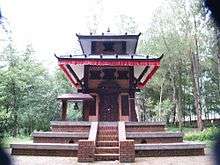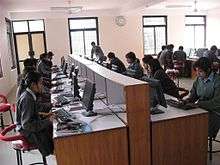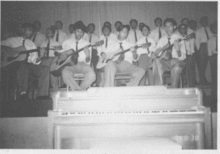Budhanilkantha School
Coordinates: 27°46′55.52″N 85°21′34.2″E / 27.7820889°N 85.359500°E
| Budhanilkantha School | |
|---|---|
 Budhanilkantha School Centre of Excellence | |
| Address | |
|
Narayansthan, Vishnu VDC Kathmandu Nepal | |
| Information | |
| Type | Public, independent school, boarding school, coeducational |
| Established | 1972 AD |
| School district | Kathmandu |
| Principal | Mr. Keshar Bahadur Khulal (BNKS alumuni) |
| Staff | around 150 |
| Faculty | 80 |
| Enrollment | 5 - 12 |
| Number of students | 1000 (approximately) |
| Nickname | BNKS |
| Endowment | N/A |
| Affiliations |
School Leaving Certificate (Grade 10) Cambridge International Examinations (A-level) Higher Secondary Education Board (10+2) |
| Website | bnks.edu.np |
Budhanilkantha School, often referred to as BNKS, is a public boarding school in Nepal. It is located in Narayansthan, 8 kilometres north of Kathmandu on the foothills of Shivapuri mountain (2,732 metres).[1] It is named after the Budhanilkantha Temple which is located nearby.
One third of pupils are granted scholarships based on merit and need after a highly selective entrance examination held in all the 75 districts of Nepal. The school aims to impart quality education for rich and poor alike in an environment that fosters unity and equality.[2]
Representing students from all districts, backgrounds, culture and tradition, Budhanilkantha school is an epitome of the diversity of Nepal. The achievements of students, a sense of integrity and respect adds fragrance to this garden of budding flowers from different species. Budhanilkantha School has been creating the best students in terms of their achievements and contributions to the world community.
Overview
The school was established in 1972.[3] The school covers about 29 hectares (574 Ropanies) of land. It is a full boarding school for students from 5th grade to A-Level, aged 10 to 19. The school is equipped with three full size multi purpose sports field, a swimming pool, assembly hall, dining hall, sports hall, Learning Resource Center, library with WiFi internet, modern science labs and living quarters for its faculty. The students come from all over Nepal.
Although the school is governed as a Public Educational Trust, it charges tuition fees for most students and also receives funding from the Ministry of Education. This makes the school a blend of private and public school. Approximately one third of the students receive scholarships based on merit and need. The scholarships are mostly funded by the Ministry of Education of Nepal.
Budhanilkantha School, since its inception has produced a considerable number of exemplary citizens. Most of its pupils go to higher education. Many of them have attended the most prestigious universities of the world and can be found active in all aspects of public life. A lot of them have risen to be enterprising businessmen, academics, researchers, doctors, lawyers, engineers, politicians, public officials and leaders of major companies.[4] The school has gained a very good reputation both within and outside Nepal.[5] However, graduates of the school are often criticised in the Nepalese media for working as highly paid professionals in United States and Western Europe and not contributing enough to the economic development efforts in Nepal, urging them to return home.[6] Perhaps, the recent examples of Budhnilkantha School students' contributions marks a contradiction in the preceding sentence. To give an example among the many initiatives of BNKS alumni: SEBS (Society of Ex-Budhanilkantha Students) has undoubtedly been a highly active NGO in Nepal and other parts of the world since 1982.
History

Budhanilkantha School was established in 1972 as a joint venture between the governments of Nepal and United Kingdom. The first batch of students took the School Leaving Certificate Examination (the national exam that is equivalent to the British O-Level) in 1980. In 1983, English was made the official language of instruction at Budhanilkantha School. The University of Cambridge(CIE) O-Level and A-Level programs were introduced in 1985.
Budhanilkantha School converted from a boys' single sex school to a co-educational institution in 1992. Co-education at Budhanilkantha has been very successful.[3]
In 1994, the British management handed over the administration to Nepalese management.
Academics
The school operates three courses of study:
- School Leaving Certificate level (a nationwide curriculum up to class 10 prescribed by the Department of Education of Nepal),
- Cambridge International A-Level and
- 10+2 Level (Higher Secondary Education Board of Nepal, equivalent alternative to A-Level).

Entry into the school is highly selective and students must pass an entrance exam to gain admission into the school. Normally, entrance examinations are taken for entry into class 5 and post SLC levels. This is intended to continue the high academic status of the school.[7]
Out of 118 students who took the School Leaving Certificate Examination 2014, 103 secured Distinction and the rest 93 students passed in the First Division.This is the best SLC result by any batches of the school. (6000D' Batch)[8]
Budhanilkantha School was the first school to introduce GCE Advanced Level in Nepal.[9] It currently offers A-Levels in Physics, Chemistry, Biology, Mathematics, Further Mathematics, Economics, Business Studies, Sociology, Accounting and English Language. It is compulsory for students to sit exams in five subjects. Mathematics and English Language have to be studied by all students. Most students choose to study science-based subjects and some choose to combine sciences and social sciences. In A-Level exams of year 2010, 12% of entries from the school secured grade A* and 30% entries secured grade A. 56% entries from the school secured more than or equal to grade B. 73% of the total entries, excluding General Paper, was on either math or science subjects.[10] Budhanilkantha students regularly feature in the Cambridge outstanding achiever list as the best achieving A-Level candidates in Nepal and worldwide.[11][12]
Governance
The school is managed under the Public Educational Trust. The Ministry for Education being the main trustee, the Board of Trustees (BOT) is chaired by the Education Secretary of Nepal. The school Management Committee (SMC) is responsible for the formulation, implementation and monitoring of all policy level matters. The Principal takes care of the day-to-day administration with the help of three Vice-Principals, Chief Administrative Officer and a team of Senior Management Team (SMT). The school is also supported by Friends of Budhanilkantha School (FOBS), the parents' representative association and Society of Ex-Budhanilkantha Students (SEBS). They also actively participate in the school governance.[13]
The present principal of the school is Mr. Keshar Khulal. There are currently two vice principals in the school; Mr. Atiram K. C. and Mrs. C. Dolma.[14]
The list of Headmasters/Principals of the school are as follows:
- John B Tyson, Headmaster Designate (1966)
- Peter J Wakeman, Headmaster (1972 to 1977)
- Ken Jones, Headmaster (1978 to 1982)
- Dr. Tej Ratna Kansakar, Acting Headmaster (1983)
- John Tyson, Headmaster (1983 to 1988)
- Brian Garton, Headmaster (1989 to 1992)
- Thomas Thomas, Headmaster (1992 to 1994)
- Satyanarayan Rajbhandari, Principal (1994 to 1995)
- Narayan Prasad Sharma, Principal (1996 to 2012)
- Keshar Khulal, Principal (2013-till date)
Infrastructure and facilities

Key infrastructures of the school are as follows:
- Three multi-purpose large sports fields: Middle Pitch, Bottom Pitch and Top Pitch.
- Three multi-purpose medium sized sports fields: Garden Pitches.
- A 25m competition swimming pool.[3]
- Four outdoor and one indoor basketball courts.
- Four volleyball courts.
- A tennis court.
- A sports hall.
- An assembly hall with stage and full light and sound support.
- A sound-proof auditorium hall.
- A spacious dining hall.
- Six fully equipped laboratories for Physics, Chemistry and Biology.
- A micro Hydro-electric Plant was installed with the help of Pestalozzi Overseas Children's Trust UK.
- The Learning Resource Centre (LRC) inaugurated by the First President of Nepal Rt. Hon. Dr. Ram Baran Yadav [15]
- Two computer labs, with latest computers and full internet access which accommodates around 80 students at a time.
- A relatively large library within the LRC with vast collections.
- A large portion of agricultural land to impart vocational education to the students.
- All the buildings are earthquake-proof, resisting up to 8.0 Richter scale.
- Most importantly, the best available infrastructure is the environment itself. Entering through the gate takes you into a different green and robust world with a united family.
During the past 25 years the school has expanded tremendously. The extension of buildings for the modern science laboratory, student hostels, class rooms, swimming pool, staff flats and office complex. The number of teaching and administrative staff has also increased. Besides this, the school has been quick to exploit changes in technology to facilitate teaching and learning.[3]
Clubs

The school has various clubs where students, especially those in the A-Level program, are handed over the responsibilities and they have to search for sponsors and organize and administer workshops, trainings, concerts and other educational programs under their own steams. The members at the end need to hand in a report of the accomplishments.
The clubs have designations for students that include President, Vice President, Secretary, Treasurer, Junior Secretary, members, coordinator, advisor that number from 10 to 35 members. The clubs running are:
- Awareness Campaign Club
- Creativity Club
- Drama And Debating Club (DADC)
- BNKS.Net
- The Environment Club
- Forum of Cultural Unity on Stage (FOCUS)
- Forum of Young Economist (FYE)
- Interact Club
- LEO Club
- Junior/Youth Red Cross Circle (J/YRCC) of Budhanilkantha School
- Science Club
- Society For Open Nepal (SFON)
- Social Service Club
- Sports Training And Recreation (STAR) Club
- Journalism Club
- Mathematics Club
- Health and Fitness Club
Other activities
Various programs and competitions are held to enhance all round development of the students. P.E. (Physical Education) Department holds various competitions among the parallel houses: basketball matches, football (Soccer) matches, Softball matches, Volleyball matches, Kabaddi matches, etc. The S.T.A.R. (Sports Recreation and Training) club also organizes Inter college football tournament in the memory of Late Narayan Khadka (Karate trainer and facilitator of the school), which is also termed as N.K. Memorial football tournament (formerly just Inter College Football Tournament). This tournament attracts spectators within and away from the school. Gyanendra Cup, an Inter College Basketball Tournament, was also organized by the school after the name of the former king of Nepal; but was stopped after the downfall of Kingship in Nepal. Other major activities related to sports are: Track and Field meets which is held annually, Pentathlon and Triathlon events, Cross country races, Road races,etc.
Notable alumni
- Dipendra Bir Bikram Shah Dev (Late King of Nepal)
- Nirajan Shah (Late Prince of Nepal)
- Nabin K Bhattarai (Singer)
- Paras Shah(Ex crown prince of Nepal)
- Birendra Bahadur Basnet (Proprietor/Managing Director of Buddha Air)
- Bhusan Dahal (media personality)
- Bal Krishna Joshi (creator of Thamel.com)
- Diwas Gurung (Neo-Nepalese folk music artist)
- Keshar Khulal (Principal, Budhanilkatha School)
- Swornim wagle (National Planning Commission, Nepal)
- Kiran Sitoula (Vice-mayor Indian Head, MY)
- Jeevan Bahadur Shahi (Minister for Culture, Tourism and Civil Aviation)
- Santosh Shah (Media Personality)
References
- ↑ http://www.vegetarian-restaurants.net/Nepal/Kathmandu-Valley/Budhanilkantha-Temple.htm
- ↑
- 1 2 3 4 http://bnks.edu.np/about/history/
- ↑ http://sebsonline.org/news/news_view.aspx?id=639
- ↑ "Archived copy". Archived from the original on 2011-03-07. Retrieved 2010-09-22.
- ↑ "Archived copy". Archived from the original on 2011-07-25. Retrieved 2010-09-23. accessed 23-Sep-2010
- ↑ http://bnks.edu.np/2010/05/12/a-level-entrance-examination/
- ↑ http://bnks.edu.np/2010/07/16/slc-results-2066/
- ↑ "Archived copy". Archived from the original on 2010-04-02. Retrieved 2010-09-23.
- ↑ http://bnks.edu.np/category/news/
- ↑ http://www.cie.org.uk/news/features/detail?feature_id=28054
- ↑ http://www.nepalnews.com/contents/2008/englishweekly/spotlight/mar/mar28/national3.php[]
- ↑ http://bnks.edu.np/about/school-management/
- ↑ http://bnks.edu.np/about/school-management/smt/
- ↑ BNKS History Archived October 10, 2007, at the Wayback Machine. accessed August 20, 2007
External links
| Wikimedia Commons has media related to Budhanilkantha School. |
- Budhanilkantha School website
- Budhanilkantha School on WikiNepal